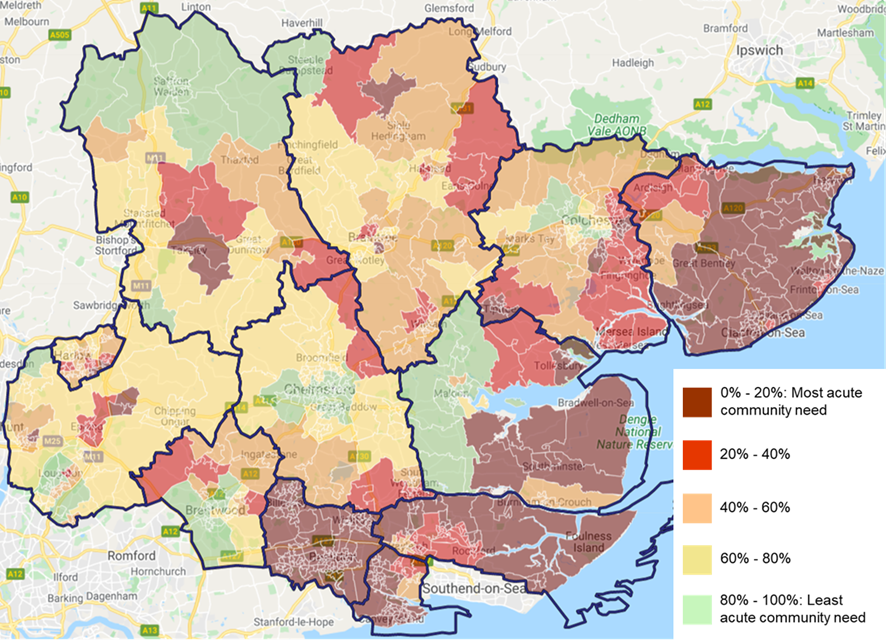Our analysis of the English Indices of Deprivation (2019) suggests that, overall, Essex compares favourably with other local authority areas, with lower levels of deprivation than 70% of upper tier authority areas.
However, Essex compares less well against other counties in the south east of England that border on, or are in close proximity to, the Greater London area. At 8.6%, the percentage of Essex residents living in the most deprived 20% of areas is amongst the highest in the South East – behind only Kent and East Sussex.
Whilst the Indices of Deprivation provide extensive and detailed information about deprivation in Essex, it does not provide a complete picture of how well-equipped or resilient individual communities are.
That’s why earlier in the year, we commissioned Oxford Consultants for Social Inclusion (OCSI) to undertake a review of community need and ‘left behind’ areas in Essex, based on a bespoke interim version of their Community Needs Index (CNI).
The CNI provides a measure of the extent to which areas have access to shared spaces and social infrastructure (the Civic Assets domain), social and physical connections (the Connectedness domain), and a thriving third sector and engaged citizens (the Active and Engaged Community domain) – all of which are seen as important in building strong, resilient communities.
The review sought to help us understand how Essex compares to other areas in terms of its levels of community need, and which factors are more significant than others in contributing to areas having high levels of need.
The evidence presented by the review suggests that overall, Essex communities appear to be less ‘well-equipped’ than communities in comparator counties and across the region and nation as a whole, with more than one-fifth of wards in Essex ranked among the 10% in England with the highest overall community need.
It found that the challenge is most acute in coastal areas, although many inland communities experience similarly significant levels of community need. The diversity of places across Essex means that no single factor accounts for higher levels of community need in Essex.
For example, communities along the Tendring coast (e.g. Clacton, Walton and Harwich) face particular challenges regarding their connectedness to economic and social opportunities, whilst areas such as Basildon and Castle Point face challenges around the availability of and access to civic assets.
The review also identified areas in Essex categorised as ‘left behind’; that is, they exhibit both high levels of deprivation and community need (being within the most deprived 10% of wards in England on both the Indices of Deprivation 2019 and the Essex Community Needs Index).
Twelve wards in Essex were identified as being ‘left-behind’: four in Clacton, four in Basildon and four in smaller coastal towns in Tendring. At 5% of all wards in the county, this was more than double the East of England average of 2.2%.
The review highlights that policies to develop and strengthen communities may need to be expressed differently in different places. While some communities experience challenges around a lack of assets and facilities, others struggle with connectedness and/or engagement.
Furthermore, it suggests that where some communities are better equipped than others, community-led approaches may inadvertently risk driving greater inequality in outcomes between places and groups.
We have recently published a summary of the work conducted by OCSI on our Essex Open Data platform which can be found here.

Leave a comment